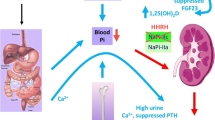Abstract.
Hypertension has been anecdotally reported in children with familial hypophosphatemic rickets (XLH). To better identify and characterize the clinical and laboratory features of hypertensive XLH children, we reviewed the medical records of 41 XLH children, all treated with phosphate and vitamin D analogues. Eight children, who were originally normotensive, developed hypertension during the 2nd decade of life. At diagnosis of hypertension all had persistent secondary/tertiary hyperparathyroidism (HPTD), defined as high serum parathyroid hormone (PTH) for 12 months or longer. Seven had nephrocalcinosis (NC). Analysis of data showed that of 11 children with HPTD, 8 developed hypertension compared with 0 among 30 without HPTD (P<0.001). Of 40 children studied, 18 had NC that was significantly associated with both HPTD (P<0.01) and hypertension (P<0.025). At diagnosis of hypertension, serum calcium was elevated in 2. Plasma renin activity was high in 3 of 4 patients in whom it was measured. Doppler ultrasonography or renal scan was normal in the 5 children studied. Early echocardiography showed left ventricular hypertrophy in only 2 of 5 children studied. In 3 patients who underwent parathyroidectomy, hypertension persisted and 1 progressed to renal failure. Serum creatinine remained normal in all others. Successful treatment of hypertension consisted of β-adrenergic blockers, angiotensin converting enzyme inhibitors, and Ca channel blockers as monotherapy or in combination. We conclude that hypertension in treated XLH children is closely associated with HPTD. Emphasis should therefore be placed on prevention of the development of HPTD as a complication of XLH treatment, and close monitoring for hypertension in those who do develop HPTD.
Similar content being viewed by others
References
Harrison HE, Harrison HC (1979) Disorders of calcium and phosphate metabolism in childhood and adolescence. Saunders, Philadelphia, pp 100–140
Chan JCM, Alon U, Hirshman GM (1985) Renal hypophosphatemic rickets. J Pediatr 106:533–544
Latta K, Hisano S, Chan CM (1993) Therapeutics of X-linked hypophosphatemic rickets. Pediatr Nephol 7:744–748
Goodyear PR, Kronick JB, Jequier S, Reade TM, Scribver CR (1987) Nephrocalcinosis and its relationship to treatment of hereditary rickets. J Pediatr 111:700–704
Verge CF, Lam A, Simpson JM, Cowell CT, Howard NJ, Silink M (1991) Effects of therapy X-linked hypophosphatemic rickets. N Engl J Med 325:1843–1848
Alon US (1997) Nephrocalcinosis. Curr Opin Pediatr 9:160–165
Nehgme R, Fahey JT, Smith C, Carpenter TO (1997) Cardiovascular abnormalities in patients with X-linked hypophosphatemia. J Clin Endocrinol Metab 82:2450–2454
Rivkees SA, El-Hajj-Fuleihan G, Brown EM, Crawford JD (1992) Tertiary hyperparathyroidism during high phosphate therapy of familial hypophosphatemic rickets. J Clin Endocrinol Metab 75:1514–1518
Alon U, Lovell HB, Donaldson DL (1992) Nephrocalcinosis, hyperparathyroidism, and renal failure in familial hypophosphatemic rickets. Clin Pediatr (Phila) 31:180–183
Wu CJ, Song YM, Sheu WH (2000) Tertiary hyperparathyroidism in X-linked hypophosphatemic rickets. Intern Med 39:468–471
Rasoulpour M (18 December 2001) Hypertension in X-linked hypophosphatemia. https://listhost.uchicago.edu/mailman/listinfo/pedneph
Lilien M (19 December 2001) Hypertension in X-linked hypophosphatemia. https://listhost.uchicago.edu/mailman/listinfo/pedneph
Filler G (3 January 2002) Hypertension in X-linked hypophosphatemia. https://listhost.uchicago.edu/mailman/listinfo/pedneph
(1996) Update on the 1987 Task Force report on high blood pressure in children and adolescents: a working group report from the National High Blood Pressure Education Program. Pediatrics 98:649–657
Davies M (1992) Primary hyperparathyroidism: Aggressive or conservative treatment? Clin Endocrinol (Oxf) 36:325–332
Stefenelli T, Abela C, Frank H, Koller-Strametz J, Globits S, Bergler-Klein J, Niederle B (1997) Cardiac abnormalities in patients with primary hyperparathyroidism: Implications for follow-up. J Clin Endocrinol Metab 82:106–112
Rastad J, Lundgren E, Ljunghall (2001) Clinical presentation of primary hyperparathyroidism. In: Bilezikian JP, Marcus R, Levine ME (eds) The parathyroids, basic and clinical concepts, 2nd edn. Academic Press, San Diego, pp 361–374
Mailloux LU, Levey AS (1998) Hypertension in patients with chronic renal disease. Am J Kidney Dis.32 (Suppl 3]:S120–S141
Rostand SG, Drüeke TB (1999) Parathyroid hormone, vitamin D, and cardiovascular disease in chronic renal failure. Kidney Int 56:383–392
Massfelder T, Taesch N, Fritsch S, Eichinger A, Barthelmebs M, Stewart A, Helwig JJ (2002) Type 1 parathyroid hormone receptor expression level modulates renal tone and plasma renin activity in spontaneously hypertensive rat. J Am Soc Nephrol 13:639–648
Vered I, Vered Z, Perez JE, Jaffe AS, Whyte MP (1990) Normal left ventricular performance in children with X-linked hypophosphatemic rickets: a doppler echocardiography study. J Bone Miner Res 5:469–474
Downing JG, Egelhoff JC, Daily DK, Thomas MK, Alon U (1992) Kidney function in very low birthweight infants with furosemide-related renal calcifications at age 1–2 years. J Pediatr 120:599–604
Alon US, Scagliotti D, Garola R (1994) Nephrocalcinosis and nephrolithiasis in infants with congestive heart failure treated with furosemide. J Pediatr 125:149–151
Li YC, Kong J, Wei M, Chen ZF, Liu SQ, Cao LP (2002) 1,25-Dihydroxyvitamin D3 is a negative endocrine regulator of the renin-angiotensin system. J Clin Invest 110:229–238
Blydt-Hansen TD, Tenenhouse HS, Goodyer P (1999) PHEX expression in parathyroid gland and parathyroid hormone dysregulation in X-linked hypophosphatemia. Pediatr Nephrol 13:607–611
Kronenberg HM (2002) NPT2a–the key to phosphate homeostasis. N Engl J Med 347:1022–1024
Acknowledgements.
This study was supported by The Sam and Helen Kaplan Research Fund in Pediatric Nephrology. The authors thank Ms. Andrea Hurst for her administrative assistance. Presented in part at the 36th ESPN meeting, Bilbao, 20–23 September 2002, and at the American Society of Nephrology 35th Annual Meeting, Philadelphia, 1–4 November 2002. Dedicated to the late Eric McClure.
Author information
Authors and Affiliations
Corresponding author
Rights and permissions
About this article
Cite this article
Alon, U.S., Monzavi, R., Lilien, M. et al. Hypertension in hypophosphatemic rickets—role of secondary hyperparathyroidism. Pediatr Nephrol 18, 155–158 (2003). https://doi.org/10.1007/s00467-002-1044-6
Received:
Revised:
Accepted:
Published:
Issue Date:
DOI: https://doi.org/10.1007/s00467-002-1044-6



